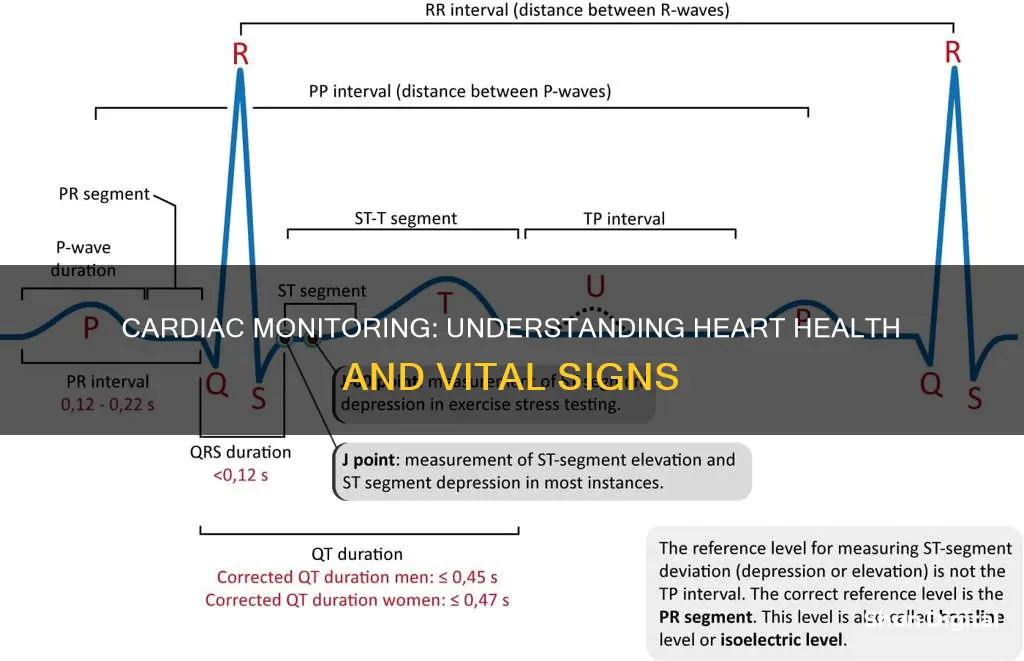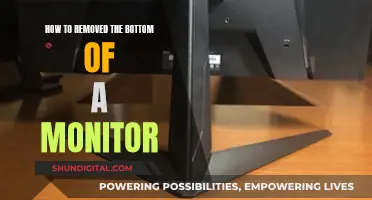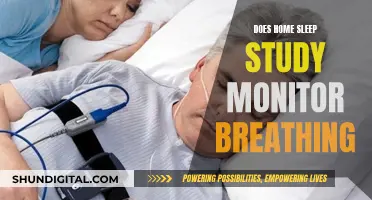
Cardiac monitoring systems are used to monitor a patient's heart health, either to diagnose a heart condition or to help manage a heart problem. These systems can be temporary or permanent, and they can be wearable or implantable. They monitor the electrical activity of the heart to ensure it is working normally, capturing important information such as heart rate, rhythm, and function. This data is then used by doctors to determine the state of a patient's heart health and decide on the best course of treatment.
| Characteristics | Values |
|---|---|
| Purpose | To record the electrical activity of the heart (ECG) |
| Format | Portable device, small box (telemetry box), or large screen on the wall (wall monitor) |
| Placement | Placed on the body using stickers called electrodes |
| Data Transfer | Can transmit data directly to a healthcare provider or send data by telephone |
| Usage | Used for long-term monitoring of symptoms that occur less than daily |
| Benefits | Eliminates the need for repeated visits to the doctor's office; allows for instant data monitoring, recording, and submission |
| Risks | Skin irritation from electrode patches |
What You'll Learn

Whether your heart is getting enough oxygen
A cardiac monitor is a device that records the electrical activity of your heart, along with your heart rate and rhythm. It can be used to monitor symptoms such as palpitations, fainting episodes, and abnormal heartbeats. While a cardiac monitor does not directly measure the oxygen levels in your heart, abnormal results may indicate that your heart is not getting enough oxygen.
Your heart needs a constant supply of oxygen-rich blood to function properly. If your heart doesn't receive enough oxygen, it can lead to serious complications and damage to the heart muscle. This condition is known as hypoxemia, which is characterised by low oxygen levels in the blood. Hypoxemia can lead to abnormal heart rhythms, palpitations, and even heart failure.
The symptoms of hypoxemia include:
- Shortness of breath
- Bluish colour of the skin, lips, or fingernails (cyanosis)
- Rapid heart rate (tachycardia)
- Headache
- Dizziness
- Lack of coordination
- Difficulty waking up
There are several ways to test for hypoxemia and monitor oxygen levels:
- Pulse Oximetry: This is a non-invasive method that uses a small clip, usually placed on your finger, to measure oxygen levels in the blood. It is a quick and painless way to check for low blood oxygen levels and can be done at home or in a hospital setting.
- Arterial Blood Gas (ABG) Test: This test involves taking a blood sample from an artery, typically in the wrist, to directly measure the level of oxygen in the blood. It is more accurate than pulse oximetry but is more invasive and can be slightly painful. ABG tests are usually performed in a hospital by a healthcare provider.
- Six-Minute Walk Test (6MWT): This test evaluates lung and heart function by measuring oxygen levels while walking on a flat surface for six minutes.
If you are experiencing symptoms of hypoxemia, it is important to seek medical attention immediately. Treatment options may include supplemental oxygen therapy, lifestyle changes, and addressing any underlying conditions that may be causing low oxygen levels.
How Do Apartments Monitor Water Usage by Each Unit?
You may want to see also

If your pacemaker is working
A cardiac event monitor is a device that records the electrical activity of your heart (ECG). It is about the size of a pager and can be worn on the wrist or kept in your pocket. It is used for long-term monitoring of symptoms that occur less than daily.
To ensure your pacemaker is working, it is important to attend periodic check-ups to assess the battery and the wires. These check-ups usually occur every 6 months to a year. During these appointments, your healthcare professional will also ensure that your medications are working and that you are taking them properly.
Additionally, you can help your pacemaker by taking any medications as prescribed and keeping a record of them. It is also important to follow your doctor's recommendations about daily activities, such as avoiding heavy lifting or causing pressure on the implantation site.
Monitoring Internet Usage: Security, Productivity, and Privacy
You may want to see also

If your medicines are working
Cardiac monitors are used to track a patient's heart rate and rhythm over an extended period. They are often used to determine whether medicines are working.
If you are taking new medication that could affect your heart, a doctor may recommend wearing a heart monitor. This is a small, portable device that records the electrical activity of your heart, providing valuable information to help diagnose heart issues.
A cardiac monitor can be used to determine how well your heart medications are working. This is particularly useful when starting or stopping a heart medicine, as it can be worn for several weeks to monitor the effects of the medication. This allows doctors to adjust the treatment as necessary.
For example, if you are taking medication for an irregular heartbeat, a cardiac monitor can track your heart rate and rhythm over time to see if the medication is effective in regulating your heartbeat. If the medication is not working as intended, the monitor will detect this, and your doctor can adjust the dosage or prescribe an alternative treatment.
Additionally, cardiac monitors can be used to check for any adverse side effects of new medications. By monitoring your heart's electrical activity, doctors can identify any abnormal heart rhythms that may be caused by the medication. This is crucial, as some heart rhythm issues may not present noticeable symptoms, and the monitor allows for early detection and intervention.
Cardiac monitors are typically recommended when a patient is experiencing symptoms such as chest pain, shortness of breath, dizziness, fainting, or a racing heartbeat. These symptoms may indicate an underlying heart condition, and the monitor helps in diagnosing and addressing the root cause.
It is important to note that cardiac monitors are usually prescribed in addition to other tests, such as an EKG or ECG, to provide a comprehensive understanding of a patient's heart health and guide treatment decisions.
Monitors: Nintendo vs Unisystem, Size Comparison
You may want to see also

If you have an irregular heartbeat
Cardiac event monitors are used for long-term monitoring of symptoms that occur infrequently, such as weekly or monthly. They can help determine whether you have an abnormal heart rhythm and, if so, what type. If you are already being treated for an irregular heartbeat, a cardiac event monitor can be used to assess the effectiveness of the treatment.
There are several types of cardiac event monitors. A looping memory monitor stores your ECG for the period before and during your symptoms. A symptom event monitor is a handheld or wearable device that is activated and placed on the chest during symptoms. An implanted loop recorder is a pager-sized heart activity recorder that is placed under the skin of the chest for up to three years.
In addition to medical treatments, your doctor may recommend lifestyle changes to help manage arrhythmias, such as eating a healthy diet, exercising regularly, limiting alcohol and caffeine intake, and managing stress.
Understanding Monitor Herz: A Guide to Refresh Rates
You may want to see also

If you need further testing
There are several types of cardiac monitoring systems available, and the right one for you will depend on your specific needs and your doctor's recommendations. Some systems are temporary and can be worn on the body, while others are permanent and implanted under the skin. Temporary monitoring systems include the BioMonitor 2, which can detect and diagnose atrial fibrillation, ventricular tachycardia, fibrillation, and syncope. Reveal LINQ is another temporary option, a tiny device that wirelessly monitors the heart for up to three years. For those who need continuous monitoring, the BIOTRONIK Home Monitoring system provides 24/7 monitoring for people with cardiac monitors, pacemakers, or implantable defibrillators.
If you have heart failure, the CardioMEMS system can help monitor your heart failure symptoms from home, transmitting data to your care team so they can adjust your medications. The LATITUDE NXT Patient Management System is another option for those with implantable cardiac devices, such as pacemakers or defibrillators, allowing for remote monitoring and communication with your care team.
Your doctor will discuss the specific risks and benefits of each system with you and determine which type of remote cardiac monitoring is most suitable for your condition. These systems can provide valuable insights into your heart health and help your care team make informed decisions about your treatment.
Signs Your Data is Being Monitored: What to Look For
You may want to see also
Frequently asked questions
A cardiac monitor is a device that records the electrical activity of your heart (ECG) to ensure it is working normally. It is about the size of a pager and can be worn on the wrist, kept in your pocket, or implanted under the skin.
A cardiac monitor tells you if your heart is working normally by measuring its electrical activity. It can detect abnormal heart rhythms and cardiac symptoms, and help diagnose an arrhythmia, or irregular heartbeat. It can also check whether treatments for abnormal heart rhythm are working.
If your doctor suspects a health condition related to your heart, or wants to ensure your heart is working properly after surgery or a new cardiac diagnosis, they may recommend a cardiac monitor. Cardiac monitors are also used for people who have symptoms that occur less often, such as weekly or monthly.







